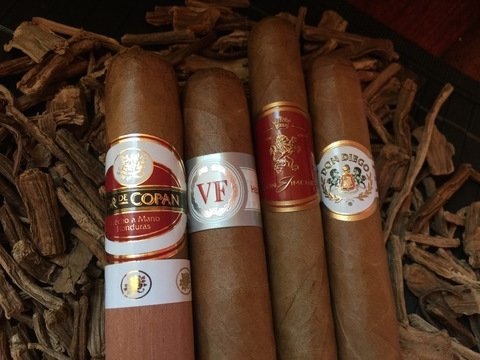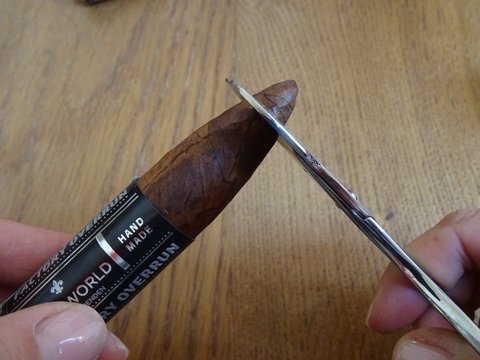Smoking a Cigar Properly - Here's How

You've made your choice and the anticipation of your cigar is growing so much that you can hardly wait to start. But before you begin smoking the cigar, there are a few details you should consider to get the most out of your enjoyment.
The Beginning of Cigar Smoking
Don’t judge a cigar only by its flavors. While it’s the flavors that bring us the most pleasure, the enjoyment begins much earlier. Even the appearance of the wrapper, whether it's a strong Maduro or a lighter Connecticut Shade, is a true delight when it comes to a good cigar. Its smell and tactile properties, the slight give under gentle pressure, make you eager for the upcoming smoke.
And let's not forget the band. Often, they are little works of art, carefully designed by illustrators. Simple yet unmistakable are the bands of the Cuban Montecristo cigars. Whether you remove it before smoking is up to each aficionado. But here you must be careful, as the wrapper could be damaged if you remove the band before its glue loosens after lighting the cigar.
Additionally, a good cigar – this goes without saying – requires the right ambience. With the fine leaves of brown gold, you are always holding a piece of cultural heritage in your hands, which deserves proper appreciation. Just as you wouldn’t rush a fine Beaujolais at a train station bistro, you should also give a cigar your full attention. Make smoking your cigar a small ritual: take your time, relax, and enjoy the cigar!
The Proper Preparation of a Cigar
Time is truly one of the most important aspects. Smoking a cigar takes between 30 to 45 minutes and, for some formats, even longer. Therefore, the preparation should be done calmly and attentively, as every enjoyment starts with the anticipation. In fact, proper storage of cigars is part of their preparation and requires some care. Once you have one of these fine pieces in hand, it's time for personal preparation, starting with cutting.

How Do You Cut a Cigar?
Hand-rolled cigars are always closed at the head. There are different ways to open them. Some may spontaneously think of the technique popular among action heroes to "bite" the cigar. While this may convey the rugged image of some Hollywood characters, it is not only completely undignified for a fine cigar, but also entirely unsuitable. This also applies to the V-cut, which was very popular in the past with older generations.
Instead, there are mainly two common and more elegant options: the cut with a special guillotine or scissors or the opening with a cigar punch. There is no definitive answer to the frequently asked question of which technique is better; it is more a matter of personal preference. When cutting, about 2-3 millimeters are removed from the head of the cigar, while the punch creates a hole in the middle of the cigar’s head. The advantage of the punch is that you cannot accidentally remove too much, and it also concentrates the smoke channels. However, its volume may be less than that of a cut. For sharp cigar formats, a punch is not ideal, and in that case, you should definitely use a guillotine or scissors.
How Do You Light a Cigar?
First, let's discuss what should be avoided: Keep away from butane lighters or sulfur-based matches! They have a scent that transfers to the cigar and distorts its flavor. Another no-go, for the same reason, are candles, no matter how romantic the idea may be.
As with cutting, there are different ways to light a cigar to achieve the desired result. Suitable tools include jet flame lighters, as well as gas lighters, (sulfur-free) matches, and cedar wood sticks. The cigar should be held at a 45-degree angle to the flame, while it is continuously rotated to ensure an even light.
For an even light, the flame should not touch the cigar, but instead, a blue heat halo forms around the end. Unlike with a cigarette, no puffs are drawn during the lighting of a cigar.
The Different Aspects of Smoking a Cigar
Finally, you're at the goal! The first puffs already tell you a lot about the quality of the cigar. If it's well made and properly cut, it will draw well. It's very important – and this is especially directed at beginners: Do not inhale the smoke of the cigar! Unlike everyday cigarettes, the smoke is not inhaled but puffed. This means you only draw the smoke into your mouth, where you experience the flavor.
To let the flavor unfold optimally, you should smoke it calmly and deliberately. Each puff should linger in the mouth for a few seconds. Play with the smoke, move it around, so that all the taste receptors on the palate and tongue are involved. Avoid any hurry and enjoy! It's not about taking a certain number of puffs per minute or anything like that – smoke according to your feeling and consciously.
If the cigar goes out, it can be relit – possibly with slight flavor loss. However, after two-thirds, you should lay it down and let it go out. In the final third of the cigar, harmful and bitter substances have accumulated, giving the cigar a harsh, sometimes very bitter taste.
Feel free to experiment. Enjoyment is a matter of personality, and over time, you will develop your own ceremonial way of tasting your cigar. Because a good smoke – that’s for sure – is one of life’s little celebrations.
How to Store a Cigar After Smoking?
Now that you've reached the last third, you might regret that the enjoyment is over. However, this is the time to reflect on the sensory impressions. Meanwhile, place the remaining cigar in a sufficiently large ashtray and let it go out. Do not crush it; instead, let it end gently before it is disposed of along with the ash.
This same care should be applied to storage. Whether you use a humidor, Amatista, or another device, you want to properly care for your cigars and ensure that their quality is always maintained.
Frequently Asked Questions:
Which Cigars Are Suitable for Beginners?
The Dominican Republic and Honduras offer a wide selection of cigars for beginners. What makes them suitable are the tobaccos with milder flavors. Smaller cigar formats like Petit Corona are also great for beginners.
How Long Does a Cuban Cigar Last?
The shelf life of a cigar depends mainly on proper storage. When handled correctly and under ideal conditions, Cuban cigars can last 15 years or longer. Initially, Havana cigars even continue to age.
How Do You Extinguish a Cigar?
Whether during the middle or at the end of the cigar, when smoking ends: a cigar does not need to be extinguished or crushed. Unlike many cigarettes, cigars quickly go out on their own because they do not contain substances that keep them smoldering.
Further topics
Discover & enjoy
In our shop you will find:






